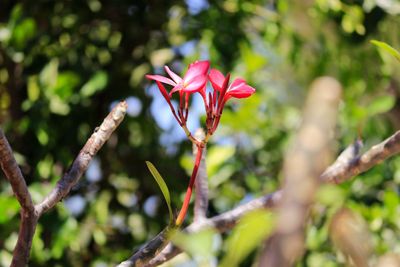Plumeria Care and Pruning
Plumeria (common name frangipani) is a small tree that grows around 30 feet (9 m.) high. It is native to tropical America and is very common in Hawaii. The leaves are glossy and pale green, while flowers are pale-colored and form a pretty pinwheel shape. They can be white, red, yellow, or pink and are often used to make leis, keeping for days. This tree loves hot and dry locations, so full sun and well-draining soil is a must. It does have some wind and salt resistance, though, so it can grow near the sea with few problems. Plumeria should be fertilized every three months for best flower production. Trim after blooming to promote healthy growth. It also needs some pruning to help maintain its size and keep it healthy.
How and When to Prune a Plumeria
Pruning plumeria can help keep the tree to a smaller size and help remove dead and diseased branches. Many gardeners wonder when is the best time to prune plumerias. When pruning a healthy tree to maintain size, it is important to prune only in the winter or early spring to avoid causing damage to the blooming cycle. Trimming off dead or diseased branches can be done at any time of the year and will not affect the blooms or harm the health of the tree. Pick the right tools to use for pruning. A sharp knife works great for smaller branches. Sharp pruning shears are good for medium size limbs. Pruning saws are good for branches that are more than 3 inches (8 cm.) in diameter. Keep your tools as sharp as possible to make even and clean cuts. Jagged, unclean cuts invite infection to the tree. Sterilize the blade of your tools after each cut. This will help prevent any disease spread, even if your tree is healthy. Rubbing alcohol is the best thing to use for sterilizing. Picking the proper location to trim is very important so you do not over or under trim the tree. If your tree is long and lanky and you want it to take on a fuller look, trim tall branches. Simply make a cut to remove the top branches. Only remove what you have too; don’t overdo it. Trimming the top off will encourage new branches to form on the side of the tree. Take a large branch that has three of four other branches protruding from it. Make the cut about 1 foot (31 cm.) above the branching point. Don’t just trim for looks, trim for the health of the tree as well. When removing dead or diseased limbs, take special precautions. Cut off any dead branch at the location of the problem. After cutting, you should see clean white sap oozing out. This is a sign of a healthy tree. If you do not see any oozing, you may need to cut the branch back further. Remember to keep tools sterile and dispose of the trimmed branches to prevent problems from spreading.
